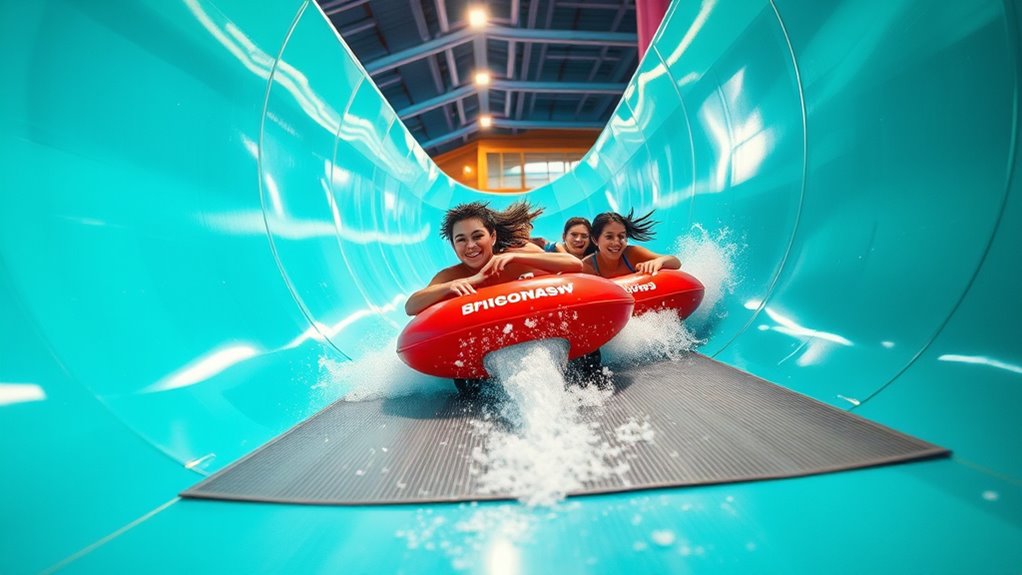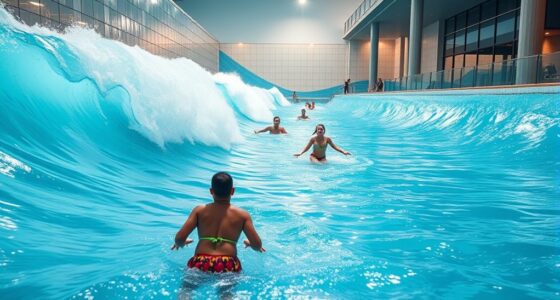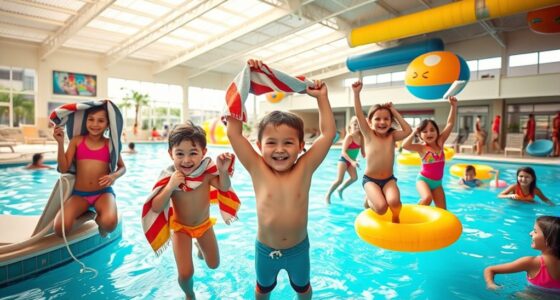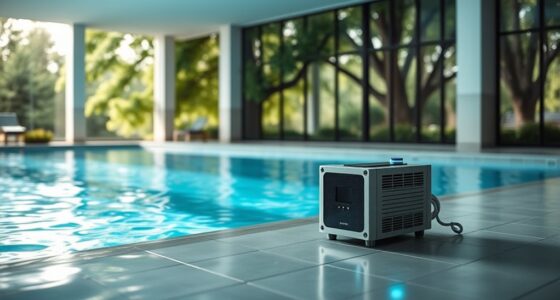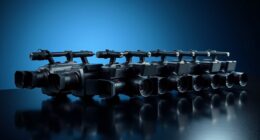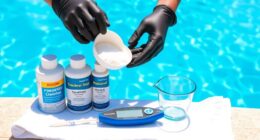Indoor water slides use water to create a thin, continuous film that reduces friction and boosts your speed. Gravity drives your acceleration down slopes, while curves can add exciting lateral forces. The slide’s materials and your swimsuit also influence how smoothly you slide. Safety features like non-slip surfaces and proper design keep you secure. To understand how all these elements combine to make your ride thrilling and safe, keep exploring the science behind indoor water slides.
Key Takeaways
- Water creates a lubricating film that reduces friction, increasing speed and smoothness on indoor water slides.
- Gravity, slope steepness, and curves influence acceleration, with water flow enhancing rapid movement.
- Surface materials, water temperature, and rider positioning affect friction levels and ride safety.
- Safety features like non-slip surfaces, signage, and regular inspections prevent accidents and ensure structural integrity.
- Turbulent water, splashes, and turns amplify thrill by increasing sensory input and perceived speed.
How Water Lubricates and Boosts Speed on Indoor Slides
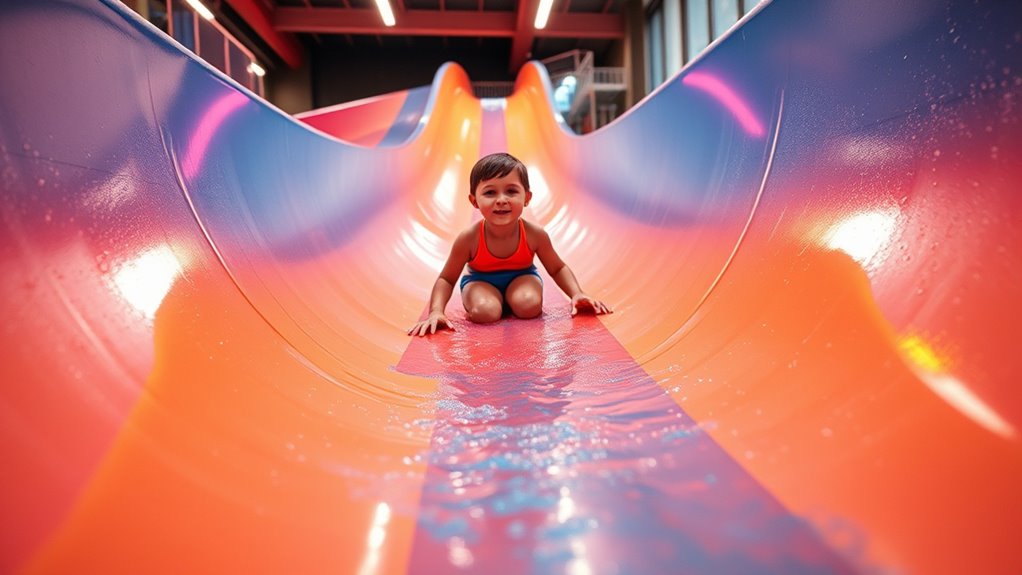
Water acts as a lubricant on indoor water slides by forming a thin film between your skin or clothing and the slide’s surface. This film reduces friction, allowing you to slide faster and more smoothly. It works like oil or grease in machinery, decreasing resistance and enabling higher speeds. The continuous flow of water maintains this lubricating layer, preventing dry spots that would slow you down. The thickness and consistency of the water film are essential; too little water causes increased friction, while too much can cause splashing and instability. Heavier riders and those wearing smooth, water-resistant clothing benefit from this lubrication, often reaching higher speeds. Without this thin water film, friction would slow you considerably, making the ride less exciting and more challenging. Experimental models simulate real water slide conditions at laboratory scale, helping researchers understand how the water flow and object properties influence sliding speed. Additionally, water flow rate plays a crucial role in maintaining optimal lubrication throughout the ride.
The Role of Gravity and Curves in Accelerating Riders

Gravity is the main force that pulls you downward as you slide, transforming your potential energy into speed. The steeper the slope, the more aligned the gravitational force is with your path, increasing acceleration. Taller slides start you higher, providing more energy for faster speeds. Curves change your direction and introduce centripetal forces, which can boost or slow your momentum. Tight curves increase lateral acceleration, making you feel faster temporarily. Proper curve design balances thrill and safety, preventing loss of control. Here’s a visualize this: Understanding the physics of motion.
| Feature | Effect |
|---|---|
| Steeper slope | Greater gravitational acceleration |
| Height of slide | More potential energy, higher speeds |
| Sharp curves | Increased lateral (centripetal) forces |
| Transition slopes | Cause acceleration changes |
| Curves and slopes combo | Complex acceleration patterns for thrill |
Factors Influencing Friction Between Riders and the Slide Surface

Several factors determine how much friction you experience as you slide, directly affecting your speed and control. The slide’s material plays a key role; fiberglass surfaces are smooth and reduce friction. Water flow acts as a lubricant, lowering friction and allowing for faster rides. Your swimsuit material matters too—spandex creates less friction than cotton, and a snug fit improves hydrodynamics. The slide surface texture influences friction levels: smoother surfaces decrease drag, while rougher ones increase it. Your positioning affects friction as well; streamlined, centered positions reduce resistance. Accessories like jewelry or loose hair can increase friction by rubbing against the slide. Water temperature and flow rate further impact friction, with warmer, faster-moving water providing better lubrication. The slide’s incline angle also impacts the force of gravity acting on you, influencing how quickly you accelerate down the slide. Additionally, the surface cleanliness of the slide can affect the amount of friction encountered, as debris or residues can create uneven textures. All these factors combine to shape your ride’s speed and smoothness.
Safety Features and Risk Management in Water Slide Design

Ensuring safety on water slides requires a combination of thoughtful design features and proactive risk management strategies. You’ll find non-slip surfaces on steps and entry points to prevent slips, while durable materials like stainless steel and fiberglass reinforce stability. Ergonomic shapes improve rider comfort and safety. Regular inspections catch potential issues early, ensuring the slide remains secure. Clear signage communicates safety rules, height, and weight limits, helping riders understand restrictions. Risk management includes enforcing size limits, supervising children, and spacing slides to prevent collisions. Communication systems, such as video monitoring and signals, keep riders safe and organized. Additionally, emergency plans are in place for injuries. Standards are continuously updated to incorporate new safety research and technological advancements, ensuring a safer environment and mitigating potential risks.
The Sensory and Thrilling Effects of Water Dynamics and Acceleration
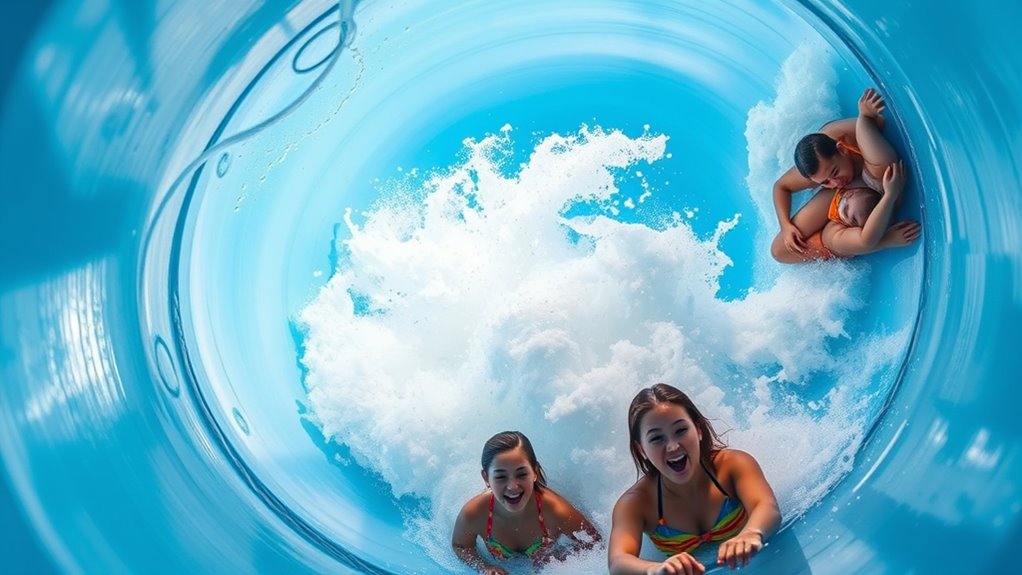
Water dynamics and acceleration create an exhilarating experience on water slides by heightening sensory stimulation and thrill. As water flows beneath you, it reduces friction, allowing you to accelerate rapidly down steeper slopes and through tight turns. High-performance water flow enhances these sensations by optimizing speed and movement. Centripetal forces in curves press you inward, intensifying sensations of g-forces and inertia. Sudden drops and slope changes cause rapid acceleration and deceleration, creating dynamic ride sensations. Near narrowing sections, high water velocity produces splashes and spray, heightening tactile and thermal senses through cool water contact. These forces and water interactions generate a feeling of weightlessness and a rush of adrenaline. Turbulent water flow adds unpredictability, while visual cues like splashes amplify the perception of speed, making each ride intensely stimulating and unforgettable. Properly managing water flow ensures a consistent and thrilling ride experience.
Frequently Asked Questions
How Do Different Clothing Materials Affect Rider Speed on Indoor Water Slides?
Your choice of clothing material considerably impacts your rider speed on indoor water slides. Synthetic fabrics like nylon and spandex dry quickly, reduce friction, and allow you to slide faster. Natural fibers such as cotton create more resistance and slow you down. Moisture-wicking synthetics keep you dry and minimize drag, while loose or absorbent fabrics increase friction. Wearing the right material helps you glide smoothly, safely, and at higher speeds.
What Specific Engineering Methods Are Used to Optimize Slide Surface Durability and Safety?
You can optimize slide surface durability and safety by using fiberglass with UV-resistant coatings and smooth gelcoats, which resist wear and UV damage. Incorporate anti-slip textures post-curing to prevent slips without affecting speed. Reinforce seams and use flame-retardant resins for structural integrity. Regular inspections, repairs, and applying protective coatings guarantee the surface stays durable and safe, meeting international standards for impact resistance and fire safety.
How Are Water Flow Patterns Controlled to Ensure Consistent Ride Dynamics?
You control water flow patterns by using sensors and adjustable valves that monitor and regulate water volume and velocity in real-time. These systems maintain a steady, optimized flow, ensuring consistent rider speeds and smooth ride experiences. Automated feedback loops adjust flow rates based on rider weight, slide conditions, and environmental factors. This precise control prevents turbulence, maintains safety, and guarantees a predictable, enjoyable ride for everyone.
What Are the Long-Term Safety Considerations for Slide Surface Materials?
You need to regularly inspect your slide surfaces for wear, cracks, or roughness that could cause injuries or reduce safety. Choose durable, corrosion-resistant materials that withstand environmental factors like UV, temperature changes, and pool chemicals. confirm slip resistance stays above safety thresholds, even when wet. Maintain proper cleaning and coatings to prevent slipping hazards, and verify materials meet safety standards for toxicity, impact resistance, and structural integrity to protect users long-term.
How Does Indoor Environmental Control Influence Water Flow and Rider Experience?
Indoor environmental control directly impacts water flow and rider experience by maintaining stable temperature and humidity levels. You guarantee consistent water viscosity and reduce condensation that causes friction variability. Proper HVAC and dehumidification keep the sliding surfaces smooth and water clear, which boosts rider comfort and safety. When you regulate these conditions effectively, you create a more predictable, enjoyable ride that minimizes risks and enhances overall guest satisfaction.
Conclusion
So, next time you race down an indoor water slide, remember it’s all about speed, friction, and safety—much more science than just fun. Ironically, the very elements that make the ride thrilling also make it risky if overlooked. You might think it’s just water and curves, but behind the scenes, scientists are balancing thrill and safety with precision. Enjoy your ride, but don’t forget—it’s a wild, scientific dance you’re part of!

